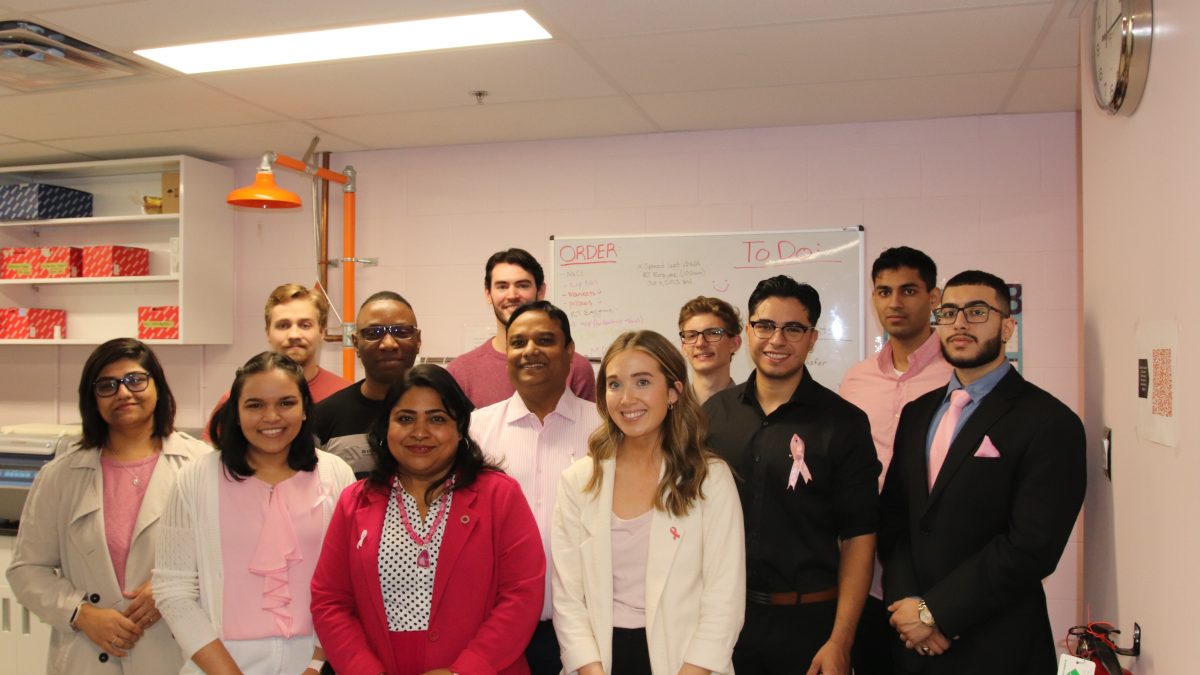Courtesy of The Brandon Sun
By Michele McDougall
A lot has happened in a year, said Brandon University’s Dr. Mousumi Majumder, as she looked around the state-of-the-art lab while her research students conduct tests they hope will lead them to a cure for breast cancer.
“We knew that even if you starve or deprive cancer cells of oxygen, they can switch which way they use sugar or glucose to make more energy,” said Majumder, professor and Canada Research Chair in Genotoxicology, adding, “but what we’re figuring out now is what kind of mechanism they use to survive this kind of stressful situation.”
Last October, a ribbon-cutting was held for the grand opening of the new Breast Cancer Cell and Molecular Research Laboratory (BCCMRL) in the basement of the Faculty of Science building at BU.
The lab was made possible by several grants that Majumder applied for, totalling $2.5 million from several organizations, including Canada Foundation for Innovation (CFI), the Breast Cancer Society of Canada and Research Manitoba.
The BCCMRL is 1,000 square feet with cutting-edge cell biology equipment, which Majumder said has allowed her to double the number of trainees to 12, comprised of master’s, honours and research students and associates.
One of the new machines that has been installed in the lab is called a hypoxic chamber, which creates an atmosphere with low oxygen. It allows the students to study tumour cell behaviour, revealing mechanisms like microRNA, Majumder said.
“MicroRNA is a molecule that can help tumour cells survive and be flexible,” Majumder said. “So, when we tried starving the cancer cell and depriving it of oxygen, we found that the MicroRNA was helping.
“And the next step is to use this information to somehow block or inhibit the microRNA pathway from helping tumor cells. If you can block them, then you have control — which is what you want in the case of cancer,” she said.
Beatrice Gatien is an honours student who is in her fifth year of a double major in biology and music. Her role is to conduct research on breast cancer cells.
“We’re taking small steps every day, working towards a cure for incurable breast cancer,” said Gatien.
Gatien said she has been growing the most aggressive and incurable type of breast cancer cells in chemotherapy for the past six to eight months to get them to develop a resistance to the drug, which she achieved.
Now, she’s trying to prevent that drug resistance from happening by using a “couple of different chemotherapy drugs,” including one that targets aggressive cells.
“What we found is that if we use chemotherapy and that new antagonist treatment, the chemotherapy works a lot better than when it’s just by itself,” Gatien said. “When I first tried this combination drug last year, I looked at the cells with just the chemotherapy and then with the combination treatment.
“The combination treatment showed about a 60 per cent increase in killing the cells. It also prevented them from migrating or spreading, which is huge for cancer. So, this combination treatment also reduced the spread.”
Reid Opperman is in his fourth year of a multi-disciplinary master’s program in Environmental Life Science at BU, focusing on biology and cancer cell biology.
He sat in front of two large monitors in the back part of the lab and looked at magnified images of cancer cells.
Opperman said his goal is looking at cells and the role they play in cancer development and how they behave and respond differently to chemotherapeutic drugs.
“One way that we can determine how the cells are responding, is to look at DNA damage,” said Opperman.
DNA is the molecule that contains the instructions needed for an organism to develop, survive and reproduce.
When Opperman started his lab work, he said it was in the original space on the second floor in the Faculty of Science building, “a very small lab.”
“So, my hope is that in 10 years, I can look back at the work that I’ve done here at BU with Dr. Majumder — and all the work she has done and know that what I’m doing will contribute some piece to understanding how patients can be better treated with breast cancer or any types of cancer. I think that would be nice,” he said.
As the data from the tests is compiled, it is analyzed by a computer scientist who also works in the lab. The “ultimate goal,” said Majumder, is to publish their research and findings in peer-reviewed medical and scientific journals.
The expanded lab and additional equipment helped a great deal with being able to submit their research, she added.
“With the cutting-edge cell biological equipment, we can understand and see every detail of the cell, so we are aiming higher,” Majumder said. “Because before we only had one microscope and now, we have at least eight different platforms to test the same hypothesis.
“So, we submitted the publication to a journal to the scientists who are the reviewers. It’s their job to figure out if the way we tested our hypothesis is correct, or if we need to do more tests to prove it.
“And I would say that they do want us to do bit more experimenting to prove the hypothesis. So, I think in a few months from now, I have more answers for you.”
» X: @enviromichele
Contact
- Brandon University
- communications@brandonu.ca
To receive any BU publication in an alternate format please contact Communications@BrandonU.ca
About BU
Success is built at Brandon University. Our growing, progressive campus welcomes a diverse and inclusive community that combines proud tradition with shared ambition. Through our excellence in teaching, research, and scholarship, we educate students to make a meaningful difference as engaged citizens and leaders. Join us at BrandonU.ca.
